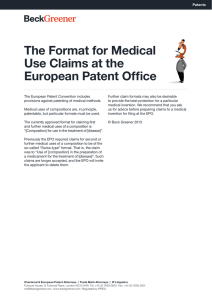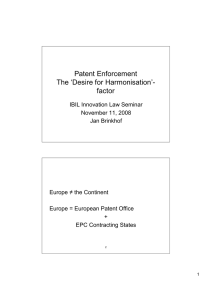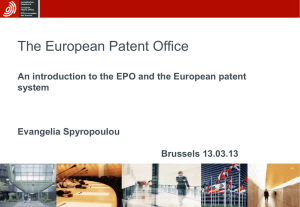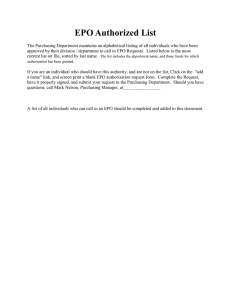EPC 2000: Revision of the European Patent Convention
advertisement
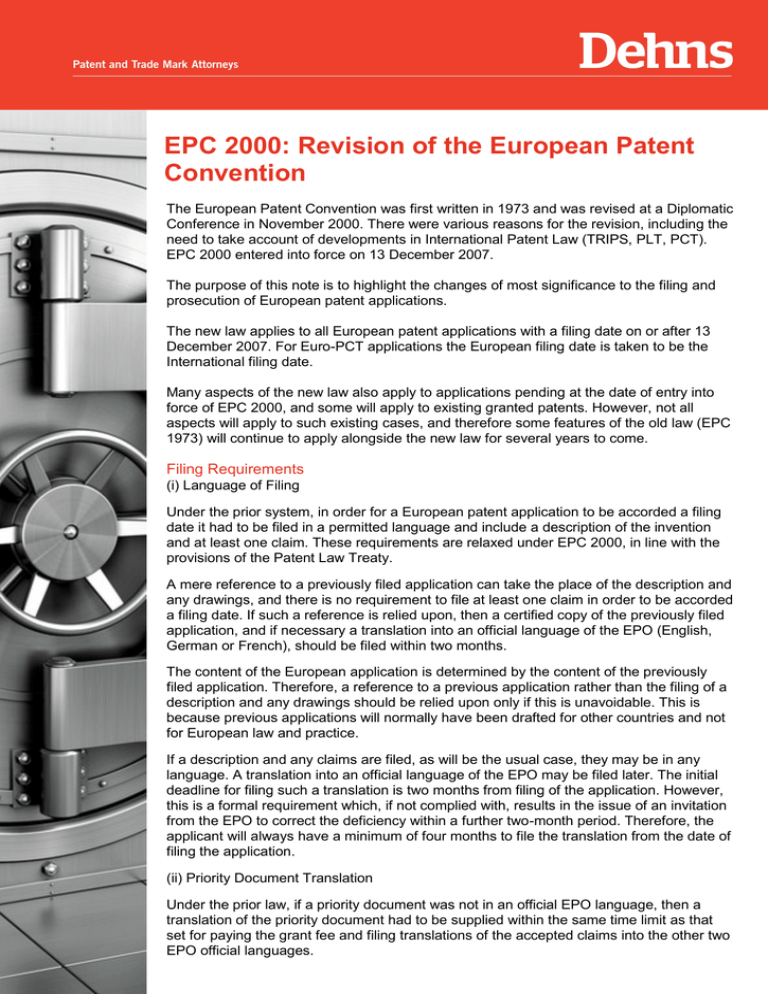
EPC 2000: Revision of the European Patent Convention The European Patent Convention was first written in 1973 and was revised at a Diplomatic Conference in November 2000. There were various reasons for the revision, including the need to take account of developments in International Patent Law (TRIPS, PLT, PCT). EPC 2000 entered into force on 13 December 2007. The purpose of this note is to highlight the changes of most significance to the filing and prosecution of European patent applications. The new law applies to all European patent applications with a filing date on or after 13 December 2007. For Euro-PCT applications the European filing date is taken to be the International filing date. Many aspects of the new law also apply to applications pending at the date of entry into force of EPC 2000, and some will apply to existing granted patents. However, not all aspects will apply to such existing cases, and therefore some features of the old law (EPC 1973) will continue to apply alongside the new law for several years to come. Filing Requirements (i) Language of Filing Under the prior system, in order for a European patent application to be accorded a filing date it had to be filed in a permitted language and include a description of the invention and at least one claim. These requirements are relaxed under EPC 2000, in line with the provisions of the Patent Law Treaty. A mere reference to a previously filed application can take the place of the description and any drawings, and there is no requirement to file at least one claim in order to be accorded a filing date. If such a reference is relied upon, then a certified copy of the previously filed application, and if necessary a translation into an official language of the EPO (English, German or French), should be filed within two months. The content of the European application is determined by the content of the previously filed application. Therefore, a reference to a previous application rather than the filing of a description and any drawings should be relied upon only if this is unavoidable. This is because previous applications will normally have been drafted for other countries and not for European law and practice. If a description and any claims are filed, as will be the usual case, they may be in any language. A translation into an official language of the EPO may be filed later. The initial deadline for filing such a translation is two months from filing of the application. However, this is a formal requirement which, if not complied with, results in the issue of an invitation from the EPO to correct the deficiency within a further two-month period. Therefore, the applicant will always have a minimum of four months to file the translation from the date of filing the application. (ii) Priority Document Translation Under the prior law, if a priority document was not in an official EPO language, then a translation of the priority document had to be supplied within the same time limit as that set for paying the grant fee and filing translations of the accepted claims into the other two EPO official languages. Under the new law, in most cases a translation of the priority document will not be required. It will only be needed when relevant to assess the patentability of the subject matter claimed, i.e. in cases where the priority date of a claim needs to be checked because of the existence of a publication between the priority date and the filing date, or the existence of another European patent application having a priority or filing date between the priority date and the filing date of the application in question. The Examiner will issue a request for a translation if the validity of the priority claim appears relevant. The new provisions apply to new applications and to existing applications where the deadline for paying the grant fee (set by the Communication under Rule 51(4) EPC 1973) had not expired on 13 December 2007. The relaxation of the requirement concerning translations of priority documents provides a significant administrative simplification and cost saving to applicants from countries which are not English, German or French speaking. This is particularly so when an application claims more than one priority. (iii) Claiming Priority Previously, priority could be claimed only from an application filed in a state which was a party to the Paris Convention. Under the new law, priority may also be claimed from an application filed in any state which is a member of the WTO (e.g. Taiwan). Under the new law, it is possible to make or correct a declaration of priority within 16 months from the earliest priority date. This is another relaxation of the prior law, which required a declaration of priority to be made at the filing date. This applies to new applications and also to existing applications where the 16-month term had not yet expired on 13 December 2007. Any new or corrected priority claim must be within 12 months preceding the filing date. There is also a new provision in which the loss of a priority right because of failure to file an application within the usual 12-month priority period can be remedied by requesting re-establishment of rights. This has to be done within two months from the date of the loss of the priority right, i.e. two months after the end of the 12-month period. This applies to new applications and also to existing applications where the two-month term had not yet expired on the date of entry into force. Re-establishment of rights is a provision which existed under the prior law, but previously it could not be used to remedy the loss of a priority right due to failure to file within the 12-month period. Rights are re-established in cases where an applicant, in spite of all due care required by the circumstances having been taken, was unable to observe a time limit. The provision therefore requires an applicant to satisfy the EPO that the necessary conditions for re-establishment have been met. Accordingly, it is important for applicants to continue to file at the EPO within 12 months of their first filing, and to seek to rely on possible re-establishment of rights only when something has gone wrong. Request for Information on Prior Art Under the prior law, the EPO could invite the applicant to provide the reference numbers of national patent applications relating to the invention to which a given European patent application related. This provision was not widely used by the EPO. Under EPC 2000, the EPO is given a new power. It may invite the applicant to provide information on prior art taken into consideration in patent proceedings elsewhere concerning the invention. Therefore, the EPO will be able to request information about prior art cited against corresponding applications. This applies to new applications and also to existing applications pending on 13 December 2007. The penalty for failure to supply the information when requested will be that the application will be deemed to be withdrawn. Euro-PCT Applications - Lack of Unity Previously, if lack of unity was found by the EPO acting as International Searching Authority during the International search and no additional International search fees were paid, under Rule 112 EPC 1973 the EPO would issue an invitation in the regional phase to pay further search fees and have additional inventions searched. Similarly, if a supplementary search was carried out by the EPO in the regional phase (this would apply when the International search report was drawn up by any International Searching Authority other than the EPO) and lack of unity was then found, the applicant was given the opportunity to pay further EPO search fees and have additional inventions searched. In both cases, examination in the regional phase could then be based on any of the inventions for which search fees had been paid. Under EPC 2000, there is no counterpart to Rule 112. Under the new law, if the EPO was the International Searching Authority, only examine an invention in the regional phase which it searched during the International phase. It is important, if the International search report is being drawn up by the EPO and non-unity is found, to consider carefully whether further search fees should be paid for inventions of interest, since there is no opportunity to pay further search fees in the regional phase and non-searched inventions can only be pursued via divisional applications. Furthermore, under the new law, any supplementary European search is carried out only on the first invention mentioned in the claims, regardless of whether or not lack of unity was found during the International search. The EPO will then examine only this invention. In light of this, it is important to ensure that the invention of greatest interest is presented first in the claims used for EPO regional phase entry so that it is searched, as again nonsearched inventions can only be pursued via divisional applications. The new law applies to all Euro-PCT applications where an invitation under old Rule 112 or a European Supplementary Search Report had not issued on 13 December 2007. Prior Art Effect of European Patent Applications The contents of European patent applications which have an earlier filing (or priority) date but are published after the filing (or priority) date of a later application are prior art for the assessment of novelty but not inventive step. This did not change under EPC 2000. However, under EPC 1973, the earlier application is only prior art for designated states designated in both applications in question and for which the designation fees have been validly paid for the earlier application. Under EPC 2000 this is simplified in that the earlier application will be prior art for all contracting states regardless of which states are actually designated in the earlier case. This new provision regarding designated states does not apply to prior art in respect of any applications pending or patents already granted on 13 December 2007 when EPC 2000 came into force. For a divisional application, the relevant date for determining whether this provision of EPC 2000 or the old law applies is the date of receipt of the divisional application at the EPO, and not the filing date of the parent application. The result is that the state of the art may be different for the parent and the divisional application. Second Medical Use Claims Methods of treatment of the human or animal body by therapy are not patentable at the EPO. However, the prior law allowed use-limited product claims directed to known substances or compositions for use in such methods (so-called first medical use claims). This is unchanged under the new law, and legal basis for use-limited product claims for a specific further medical use is introduced for the first time. Under the new law, claims directed to compound X for use in a specified second or further medical use are also allowed, providing that the specified new use is both novel and inventive. This provision applies to new applications and to all existing European applications where a decision on the grant of the patent had not yet been taken when EPC 2000 entered into force. After Grant Previously, outside of opposition proceedings, there was no centralised mechanism for amending European patents post-grant, and amendment had to be sought separately in each contracting state. The new law introduced for the first time a centralised mechanism for requesting amendment of a patent post-grant at the EPO. The new system greatly simplifies the procedures, and reduces the cost, of seeking amendment of a granted European patent. Under new Article 105a, a patent proprietor may request that the scope of protection of his patent be limited by an amendment of the claims, or that the patent be revoked completely. Any such limitation or revocation will have effect backdated to the date of grant of the patent. The procedure involves examination only that the amendment is truly a limitation, that there is basis in the specification as filed for the amendment, and that the amendment is clear. The EPO will not examine the amended claims for novelty or inventive step. The procedure is not open to opposition by third parties. The EPO’s decision to limit or revoke the European patent will be effective in all of the contracting states in respect of which it has been granted. The new law applies to all patents granted before, on or after the date of entry into force. There is no limitation on the number of times a single patent may be amended using this procedure. The procedure for filing an Opposition against a European patent up to nine months from the grant date remained in place under EPC 2000. If an Opposition is filed, then the EPO will terminate any limitation proceedings already commenced by the patent proprietor, and if any request for limitation or revocation is filed when Opposition proceedings are pending, then the request is deemed not to have been filed. Other Changes There are several other changes which are not dealt with in this note. These include: introduction of limited possibilities to request that the Enlarged Board of Appeal review a decision of a Technical Board of Appeal on procedural (but not substantive) grounds. This applies only to decisions taken after the entry into force of EPC 2000. a new Article 2 of the Protocol on Interpretation of Article 69 relating to the extent of protection conferred by a European patent, saying that due account shall be taken of any element which is equivalent to an element specified in the claims. This applies to all patents granted before, on or after the date of entry into force. Summary The major points covered in this note are: EPC 2000 entered into force on 13 December 2007. a European patent application can be filed in any language, with a translation following later, within a period of time of at least four months. a translation of the priority document will not be required unless requested by the EPO for assessing patentability. This applies to new applications and also to existing applications where the time limit for paying the grant fee set by the Communication under Rule 51(4) EPC 1973 had not expired on 13 December 2007. a declaration of priority can be made or corrected up to 16 months from the earliest priority date. the loss of a priority right because of failure to file an application within the usual 12-month priority period can be remedied by requesting re-establishment of rights within two months of the end of the priority year, but re-establishment is possible only in certain limited circumstances. the prior act effect of earlier unpublished European patent applications has been extended to all contracting states. introduction of use-limited product claims for claiming the second medical use of a compound or substance. This applies to new applications and to all existing European applications where a decision on the grant of the patent had not yet been taken when EPC 2000 entered into force. the EPO has the power to request information on prior art taken into consideration in relation to patent applications elsewhere concerning the invention. This applies to new applications and also to existing applications pending at the date of entry into force. careful thought needs to be given to the question of paying additional search fees during the International phases of PCT applications, given the consequences that non-payment has for prosecution in the subsequent European regional phase. an owner of a European patent may request central limitation or revocation of the patent at any time during its lifetime, unless Opposition proceedings are pending at the EPO. This applies to all patents granted before, on or after the date of entry into force. Further advice If you would like any further advice please contact us at Dehns using the details below. Copyright 2010. The information in this document is necessarily of a general nature and is given by way of guidance only. Specific legal advice should be sought on any particular matter. Dehns accepts no responsibility whatsoever for any action taken or not taken on the basis of the information contained herein. (Last updated June 2013 - ARB)
